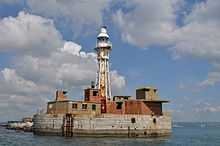Portland Breakwater Lighthouse, Dorset

The Portland Breakwater Lighthouse is a functioning lighthouse located at the Isle of Portland, Dorset, England. The lighthouse is located in the commercial port of Portland Harbour, situated on the southern end of northeast breakwater, sitting close to the main derelict Portland Breakwater Fort, where the lighthouse operates in one of the largest man-made harbours in the world.[1] It is often rather forgotten by the public in regards to Portland's lighthouses.
History

The lighthouse was established in 1905 and has continued to function ever since. The first Portland breakwater light was shown in 1851, and afterwards from the fort at the end of the breakwater as then completed in 1876, before the lighthouse first shone out in 1905.[2] It was decided to supersede the navigational light on top of the fort with the lighthouse close by, as under the rules of war the enemy is forbidden to fire at a lighthouse and so the fort guns would have had an advantage during the First World War.
The grand structure that sits alone on A-Head at the south end of the middle Breakwater. Lying inside Portland's boundary stone, the lighthouse is at the height of 22 metres and is essentially a white hexagonal structure - including a cast iron skeletal tower with a central cylinder.[3] The entire upper section, including the windows and dome roof, was made of cast Phospher Bronze, whilst the spiral staircase is both narrow and steep. Surrounding the lighthouse a small fort and various defensive buildings such as pillboxes.[4]
The lighthouse was originally lit by oil in the early 20th century, before it was changed to gas which used a clockwork turning mechanism. Today it is lit electrically with a modern LED lamp. In its current state, the lighthouse remains somewhat worn but still usable, after both weather and vandals have taken toll on it. Before being automated three lighthouse keepers manned the lighthouse. It was owned by the Admiralty and operated by Trinity House on their behalf, where the staff were paid by Admiralty and not Trinity House.[5][6]
As a target of vandalism, the bronze vents inside have all been removed by thieves, and attempts to take the small door to the outside walkway around the light failed as it is seized solid. Today, the lighthouse still has the old battery back-up banks under the Light floor, and the clockwork mechanism is still visible, but parts of it have been removed. A reported rumour in recent years spoke of the plans for the lighthouse to be removed, and refitted in Osprey Quay as a centre piece, as an attempt to give the lighthouse a new lease of life.[7]
In 2002, the lighthouse was used by the South Dorset Radio Society - the first Radio Club to operate from the Lighthouse at Portland Bill during a Jamboree on the Air weekend as part of the Lighthouse and Lightships Weekend. For the third year that SDRS would operate from Portland Bill for the event - the club forced to cancel operations at the last moment owing to the unavailability of the site. At very short notice, SDRS set up an alternative station using their club call-sign GX3SDS/P from the Portland Breakwater Lighthouse.[8]
The lighthouse's current use continues to aid navigation of boats in the area, protecting mariners from collision with the Breakwaters, where it gives a white flash every 10 seconds.[3] One of the lighthouse's disused optical lens is displayed at Weymouth Museum, within Brewers Quay.
Lighthouse Staff
In the September 2005 newsletter of the South Dorset Amateur Radio, John Trotter of Australia, recalled memories of working at the lighthouse during the 1960s.[5][6]
| “ | I was a supernumerary Assistant Keeper at Portland Breakwater Lighthouse in 1966 - I did 2 two month stints. We (there were three of us) lived in one of the buildings, known then as "the dwelling", just down from the light tower. We had to climb them every two hours during the night to wind up the lens and pump oil up to the lamp. The breakwater was shared with about a million rats and each time you went out at night there would be a carpet of them fleeing from the torchlight. We took it in turns to go ashore for one morning a week. That was a few hours in Weymouth, accompanied by a mild panic about missing the launch back from the naval base. One abiding memory of the time is watching Weymouth lifeboat taking the Mayor out to the Shambles Light Vessel with a load of Christmas goodies. Apparently, they used to call at the Breakwater too until some bad tempered Principal Keeper told them to ****** off. Consequently, we just stood there like neglected basset hounds watching her pass by. Eventually, Trinity House promoted me to Assistant Keeper and appointed me to the Breakwater on a permanent basis, but the idea of spending a lifetime as a keeper didn't really appeal so I resigned. | ” |
References
- ↑ Breakwater Fort. "Dorset - History - Breakwater Fort". BBC. Retrieved 2012-11-21.
- ↑ Scribbles. "Dorset Maritime History". Pbenyon.plus.com. Retrieved 2012-11-21.
- ↑ 3.0 3.1 "Foghorn Publishing ... Lighthouse Explorer Database ... Portland Breakwater Light (England)". Lighthousedigest.com. Retrieved 2012-11-21.
- ↑ "Eastern Breakwater Portland Harbour:: OS grid SY7076 :: Geograph Britain and Ireland - photograph every grid square!". Geograph.org.uk. Retrieved 2012-11-21.
- ↑ 5.0 5.1 "SDRS Catswhisker Contents - South Dorset Amateur Radio". Sites.google.com. Retrieved 2012-11-21.
- ↑ 6.0 6.1 "Powered by Google Docs". Docs.google.com. Retrieved 2012-11-21.
- ↑ Andy J Straw (2010-04-25). "Portland's 4th Lighthouse". Portland Rover. Retrieved 2012-11-21.
- ↑ "ILLW Portland (and the move to the Nothe Fort) - South Dorset Amateur Radio". Sites.google.com. Retrieved 2012-11-21.
Coordinates: 50°34′06″N 2°25′34″W / 50.5682°N 2.4261°W
| ||||||||||||||||||||||||||||||||||||||||||||||||||||||||||||||||||